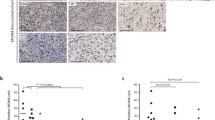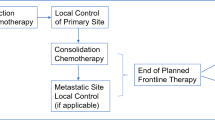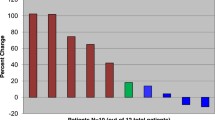Abstract
Objectives
High-dose chemotherapy with the alkylating agent busulfan has been widely used in the treatment of patients with high-risk Ewing’s sarcoma. Because of risks for toxicity, busulfan and radiotherapy can not be applied together, leading to the omission of one effective therapy component. Treosulfan is a derivative of busulfan which has a lower side effect profile than busulfan and which can be used together with radiotherapy. We investigated the effect of treosulfan in a panel of Ewing’s sarcoma cell lines on cell survival, cell cycle and apoptosis in vitro and compared it to busulfan. Furthermore, the anti-tumor effect of treosulfan was studied in an orthotopic Ewing’s sarcoma mouse xenograft model.
Methods
Cell survival was measured by MTT assay and cell cycle analysis by flow cytometry. Apoptosis was analyzed via detection of DNA fragmentation, Hoechst 33258 staining, Annexin V, and cleavage of caspases-3 and 9. The effect of treosulfan and busulfan on primary tumor growth was assessed in Ewing’s sarcoma xenografts in NOD/SCID mice (10 mice per group), pharmacokinetics of treosulfan were analyzed in nude mice.
Results
Treosulfan inhibited cell growth to at least 70% in all cell lines at concentrations achievable in vivo. Treosulfan had a greater effect on the inhibition of cell growth at equivalent concentrations compared to busulfan. The growth inhibitory effect of treosulfan at low concentrations was mainly due to a G2 cell cycle arrest, whereas at higher concentrations it was due to apoptosis. Apoptosis was induced at lower concentrations compared to busulfan. In contrast to busulfan, treosulfan induced cell death in an apoptosis-deficient cell line at concentrations achievable in vivo. In mice, treosulfan suppressed tumor growth at dosages of 2,500 and 3,000 mg/kg. Pharmacokinetic exposures of treosulfan in mice were similar to previous reports in human patients. At maximal tolerated dosages treosulfan had a higher anti-tumor activity than busulfan.
Conclusions
Our results suggest that treosulfan has efficacy against Ewing’s sarcoma cells in vitro and in mice. Therefore, controlled trials examining the role of treosulfan in patients with Ewing’s sarcoma are warranted.










Similar content being viewed by others
Abbreviations
- ES:
-
Ewing’s sarcoma
- MTT:
-
3-(4,5-dimethylthiazol-2yl)-2,5-diphenyltetrazolium bromide
- AUC:
-
Area under the curve
References
Khoury JD (2005) Ewing sarcoma family of tumors. Adv Anat Pathol 12:212–220
Delattre O, Zucman J, Plougastel B, Desmaze C, Melot T, Peter M, Kovar H, Joubert I, de Jong P, Rouleau G (1992) Gene fusion with an ETS DNA-binding domain caused by chromosome translocation in human tumours. Nature 359:162–165
Paulussen M, Ahrens S, Dunst J, Winkelmann W, Exner GU, Kotz R, Amann G, Dockhorn-Dworniczak B, Harms D, Muller-Weihrich S, Welte K, Kornhuber B, Janka-Schaub G, Gobel U, Treuner J, Voute PA, Zoubek A, Gadner H, Jurgens H (2001) Localized Ewing tumor of bone: final results of the cooperative Ewing’s Sarcoma Study CESS 86. J Clin Oncol 19:1818–1829
Cotterill SJ, Ahrens S, Paulussen M, Jurgens HF, Voute PA, Gadner H, Craft AW (2000) Prognostic factors in Ewing’s tumor of bone: analysis of 975 patients from the European Intergroup Cooperative Ewing’s Sarcoma Study Group. J Clin Oncol 18:3108–3114
Rodriguez-Galindo C, Billups CA, Kun LE, Rao BN, Pratt CB, Merchant TE, Santana VM, Pappo AS (2002) Survival after recurrence of Ewing tumors: the St Jude Children’s Research Hospital experience, 1979–1999. Cancer 94:561–569
Frohlich B, Ahrens S, Burdach S, Klingebiel T, Ladenstein R, Paulussen M, Zoubek A, Jurgens H (1999) High-dosage chemotherapy in primary metastasized and relapsed Ewing’s sarcoma. (EI)CESS. Klin Padiatr 211:284–290
Ladenstein R, Lasset C, Pinkerton R, Zucker JM, Peters C, Burdach S, Pardo N, Dallorso S, Coze C (1995) Impact of megatherapy in children with high-risk Ewing’s tumours in complete remission: a report from the EBMT Solid Tumour Registry. Bone Marrow Transplant 15:697–705
Hassan M (1999) The role of busulfan in bone marrow transplantation. Med Oncol 16:166–176
van der Jagt RH, Appelbaum FR, Petersen FB, Bigelow CL, Fisher LD, Schoch GH, Buckner CD, Sanders JE, Storb R, Sullivan KM (1991) Busulfan and cyclophosphamide as a preparative regimen for bone marrow transplantation in patients with prior chest radiotherapy. Bone Marrow Transplant 8:211–215
Gropp M, Meier W, Hepp H (1998) Treosulfan as an effective second-line therapy in ovarian cancer. Gynecol Oncol 71:94–98
Hartley JA, O’Hare CC, Baumgart J (1999) DNA alkylation and interstrand cross-linking by treosulfan. Br J Cancer 79:264–266
Koenigsmann M, Mohren M, Jentsch-Ullrich K, Franke A, Becker E, Heim M, Freund M, Casper J (2004) High-dose treosulfan in patients with relapsed or refractory high-grade lymphoma receiving tandem autologous blood stem cell transplantation. Bone Marrow Transplant 34:477–483
Beelen DW, Trenschel R, Casper J, Freund M, Hilger RA, Scheulen ME, Basara N, Fauser AA, Hertenstein B, Mylius HA, Baumgart J, Pichlmeier U, Hahn JR, Holler E (2005) Dose-escalated treosulphan in combination with cyclophosphamide as a new preparative regimen for allogeneic haematopoietic stem cell transplantation in patients with an increased risk for regimen-related complications. Bone Marrow Transplant 35:233–241
Bitan M, Shapira MY, Resnick IB, Zilberman I, Miron S, Samuel S, Ackerstein A, Elad S, Israel S, Amar A, Fibach E, Or R, Slavin S (2005) Successful transplantation of haploidentically mismatched peripheral blood stem cells using CD133+-purified stem cells. Exp Hematol 33:713–718
Casper J, Wilhelm S, Steiner B, Wolff D, Grobe N, Hahling D, Hartung G, Hilgendorf I, Luck A, Junghanss C, Kahl C, Baumgart J, Pichlmeier U, Freund M (2005) Allogeneic blood stem cell transplantation in high-risk patients after conditioning with treosulfan and fludarabine. Dtsch Med Wochenschr 130:2125–2129
Kroger N, Shimoni A, Zabelina T, Schieder H, Panse J, Ayuk F, Wolschke C, Renges H, Dahlke J, Atanackovic D, Nagler A, Zander A (2006) Reduced-toxicity conditioning with treosulfan, fludarabine and ATG as preparative regimen for allogeneic stem cell transplantation (alloSCT) in elderly patients with secondary acute myeloid leukemia (sAML) or myelodysplastic syndrome (MDS). Bone Marrow Transplant 37:339–344
Fruehauf S, Buss EC, Tropaly J, Kreipe HH, Ho AD (2005) Myeloablative conditioning in myelofibrosis using i.v. treosulfan and autologous peripheral blood progenitor cell transplantation with high doses of CD34+ cells results in hematologic responses. A follow-up of three patients. Haematologica 90:ECR08
Markiewicz M, Wojciechowska M, Wylezol I, Wozniczka K, Giebel S, Wojnar J, Krawczyk-Kulis M, Mendek-Czajkowska E, Holowiecki J (2006) Unrelated donor bone marrow transplantation with treosulfan-based myeloablative conditioning for paroxysmal nocturnal hemoglobinuria-successful treatment despite multiple transplant-related risk factors for hemolysis including major Kidd group incompatibility. Bone Marrow Transplant 37:231–232
Wachowiak J, Chybicka A, Kowalczyk J, Boruczkowski D, Gorczynska E, Wojcik B, Leda M, Drabko K, Pieczonka A, Turkiewicz D, Kawak K, Choma M (2005) Retrospective study on treosulfan-based preparative regimen for allogeneic HSCT in children with hematological malignancies and high risk of conventional regimen related toxicity. Bone Marrow Transplant 35(S2):261 (Abstract)
Drabko K, Zawitkowska-Klaczynska J, Wojcik B, Choma M, Zaucha-Prazmo A, Kowalczyk J, Gorczynska E, Toporski J, Kalwak K, Turkiewicz D, Chybicka A (2005) Megachemotherapy followed by autologous stem cell transplantation in children with Ewing’s sarcoma. Pediatr Transplant 9:618–621
Lanvers-Kaminsky C, Bremer A, Dirksen U, Jurgens H, Boos J (2006) Cytotoxicity of treosulfan and busulfan on pediatric tumor cell lines. Anticancer Drugs 17:657–662
Dirksen U (2007) Treosulfan high dose therapy with autologous stem cell rescue in high-risk Ewing tumors. J Clin Oncol 25(18S):100039 (Abstract)
Kontny HU, Lehrnbecher TM, Chanock SJ, Mackall CL (1998) Simultaneous expression of Fas and nonfunctional Fas ligand in Ewing’s sarcoma. Cancer Res 58:5842–5849
Kontny HU, Hammerle K, Klein R, Shayan P, Mackall CL, Niemeyer CM (2001) Sensitivity of Ewing’s sarcoma to TRAIL-induced apoptosis. Cell Death Differ 8:506–514
Meric F, Liao Y, Lee WP, Pollock RE, Hung MC (2000) Adenovirus 5 early region 1A does not induce expression of the ewing sarcoma fusion product EWS-FLI1 in breast and ovarian cancer cell lines. Clin Cancer Res 6:3832–3836
Merino ME, Navid F, Christensen BL, Toretsky JA, Helman LJ, Cheung NK, Mackall CL (2001) Immunomagnetic purging of Ewing’s sarcoma from blood and bone marrow: quantitation by real-time polymerase chain reaction. J Clin Oncol 19:3649–3659
Pagani A, Fischer-Colbrie R, Eder U, Pellin A, Llombart-Bosch A, Bussolati G (1995) Neural and mesenchymal differentiations in Ewing’s sarcoma cell lines. Morphological, immunophenotypic, molecular biological and cytogenetic evidence. Int J Cancer 63:738–743
Yee D, Favoni RE, Lebovic GS, Lombana F, Powell DR, Reynolds CP, Rosen N (1990) Insulin-like growth factor I expression by tumors of neuroectodermal origin with the t(11;22) chromosomal translocation. A potential autocrine growth factor. J Clin Invest 86:1806–1814
Uslu R, Jewett A, Bonavida B (1996) Sensitization of human ovarian tumor cells by subtoxic CDDP to anti-fas antibody-mediated cytotoxicity and apoptosis. Gynecol Oncol 62:282–291
Nicoletti I, Migliorati G, Pagliacci MC, Grignani F, Riccardi C (1991) A rapid and simple method for measuring thymocyte apoptosis by propidium iodide staining and flow cytometry. J Immunol Methods 139:271–279
Erlacher M, Labi V, Manzl C, Bock G, Tzankov A, Hacker G, Michalak E, Strasser A, Villunger A (2006) Puma cooperates with Bim, the rate-limiting BH3-only protein in cell death during lymphocyte development, in apoptosis induction. J Exp Med 203:2939–2951
Hilger RA, Harstrick A, Eberhardt W, Oberhoff C, Skorzec M, Baumgart J, Seeber S, Scheulen ME (1998) Clinical pharmacokinetics of intravenous treosulfan in patients with advanced solid tumors. Cancer Chemother Pharmacol 42:99–104
Tanswell P, Heinzel G, Weisenberger H, Roth W (1995) Pharmacokinetic-pharmacodynamic and metabolite modeling with TopFit. Int J Clin Pharmacol Ther 33:550–554
Scheulen ME, Hilger RA, Oberhoff C, Casper J, Freund M, Josten KM, Bornhauser M, Ehninger G, Berdel WE, Baumgart J, Harstrick A, Bojko P, Wolf HH, Schindler AE, Seeber S (2000) Clinical phase I dose escalation and pharmacokinetic study of high-dose chemotherapy with treosulfan and autologous peripheral blood stem cell transplantation in patients with advanced malignancies. Clin Cancer Res 6:4209–4216
Fernandez HF, Tran HT, Albrecht F, Lennon S, Caldera H, Goodman MS (2002) Evaluation of safety and pharmacokinetics of administering intravenous busulfan in a twice-daily or daily schedule to patients with advanced hematologic malignant disease undergoing stem cell transplantation. Biol Blood Marrow Transplant 8:486–492
Martin SJ, Reutelingsperger CP, McGahon AJ, Rader JA, van Schie RC, LaFace DM, Green DR (1995) Early redistribution of plasma membrane phosphatidylserine is a general feature of apoptosis regardless of the initiating stimulus: inhibition by overexpression of Bcl-2 and Abl. J Exp Med 182:1545–1556
Sun XM, MacFarlane M, Zhuang J, Wolf BB, Green DR, Cohen GM (1999) Distinct caspase cascades are initiated in receptor-mediated and chemical-induced apoptosis. J Biol Chem 274:5053–5060
Fichtner I, Becker M, Baumgart J (2003) Antileukaemic activity of treosulfan in xenografted human acute lymphoblastic leukaemias (ALL). Eur J Cancer 39:801–807
Bosanquet AG, Burlton AR (1994) Airborne cytotoxicity in the DiSC assay caused by solutions of treosulfan but not busulphan. Cytotechnology 16:131–136
Pauwels O, Atassi G, Kiss R (1995) Combination of computerized morphonuclear and multivariate analyses to characterize in vitro the antineoplastic effect of alkylating agents. J Pharmacol Toxicol Methods 33:35–45
Lavrik IN, Golks A, Krammer PH (2005) Caspases: pharmacological manipulation of cell death. J Clin Invest 115:2665–2672
Ploemacher RE, Johnson KW, Rombouts EJ, Etienne K, Westerhof GR, Baumgart J, White-Scharf ME, Down JD (2004) Addition of treosulfan to a nonmyeloablative conditioning regimen results in enhanced chimerism and immunologic tolerance in an experimental allogeneic bone marrow transplant model. Biol Blood Marrow Transplant 10:236–245
Bernstein M, Kovar H, Paulussen M, Randall RL, Schuck A, Teot LA, Juergens H (2006) Ewing’s sarcoma family of tumors: current management. Oncologist 11:503–519
Paulussen M, Frohlich B, Jurgens H (2001) Ewing tumour: incidence, prognosis and treatment options. Paediatr Drugs 3:899–913
Boland I, Vassal G, Morizet J, Terrier-Lacombe MJ, Valteau-Couanet D, Kalifa C, Hartmann O, Gouyette A (1999) Busulphan is active against neuroblastoma and medulloblastoma xenografts in athymic mice at clinically achievable plasma drug concentrations. Br J Cancer 79:787–792
Ashizuka S, Peranteau WH, Hayashi S, Flake AW (2006) Busulfan-conditioned bone marrow transplantation results in high-level allogeneic chimerism in mice made tolerant by in utero hematopoietic cell transplantation. Exp Hematol 34:359–368
Acknowledgments
We would like to thank Mwe Mwe Chao, MD for helpful comments. This work was funded by the Forschungskommission of the Faculty of Medicine of the University of Freiburg.
Author information
Authors and Affiliations
Corresponding author
Rights and permissions
About this article
Cite this article
Werner, S., Mendoza, A., Hilger, R.A. et al. Preclinical studies of treosulfan demonstrate potent activity in Ewing’s sarcoma. Cancer Chemother Pharmacol 62, 19–31 (2008). https://doi.org/10.1007/s00280-007-0566-9
Received:
Accepted:
Published:
Issue Date:
DOI: https://doi.org/10.1007/s00280-007-0566-9




